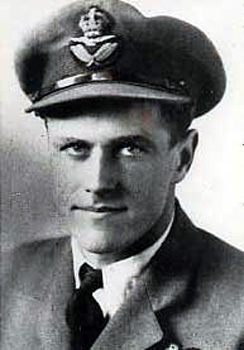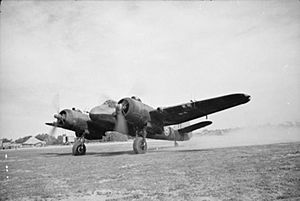Victor Verity facts for kids
Quick facts for kids
Victor Verity
|
|
|---|---|

Verity, c. 1939–1945
|
|
| Birth name | Victor Bosanquet Strachan Verity |
| Born | 5 November 1919 Timaru, New Zealand |
| Died | 2 February 1979 (aged 59) Wellington, New Zealand |
| Allegiance |
|
| Service/ |
|
| Years of service | 1938–1943 (RAF) 1943–1945 (RNZAF) |
| Rank | Squadron leader |
| Commands held | No. 650 Squadron |
| Battles/wars |
|
| Awards | Distinguished Flying Cross |
Victor Bosanquet Strachan Verity (5 November 1919 – 2 February 1979) was a brave New Zealand flying ace during the Second World War. A flying ace is a pilot who has shot down at least five enemy aircraft. Victor Verity flew for the Royal Air Force (RAF) and is known for destroying at least eight enemy planes.
Contents
Early Life and Training
Victor Verity was born in Timaru, New Zealand, on 5 November 1919. His father was a farmer. Victor went to Longridge School and then Timaru Boys' High School from 1932 to 1934. After school, he worked on his family's farm.
Victor always wanted to join the Royal Air Force (RAF). He applied for a special short-term job as an officer, which was accepted. He left New Zealand for the United Kingdom on 1 February 1939, traveling by ship.
His flight training started at the No. 11 Elementary & Reserve Flying Training School near Perth. After this, he officially joined the RAF as a pilot officer. In May, Victor went to No. 9 Flying Training School, where he earned his pilot's wings. In November 1939, he was sent to No. 229 Squadron.
World War II Service
When the Second World War began, Victor's new unit, No. 229 Squadron, was based at Digby. It was part of RAF Fighter Command and first used Bristol Blenheim planes. By late December, the squadron was ready for action, flying patrols over the North Sea to protect British fishing boats. They also started training for night-fighting missions. In March 1940, the squadron began using Hawker Hurricane fighter planes.
Fighting in France
On 14 May, Victor and two other pilots joined No. 615 Squadron. This squadron was in France and was fighting hard against the Luftwaffe (the German air force). On 20 May, Victor damaged two Junkers Ju 88 bombers. However, his Hurricane was attacked by German Messerschmitt Bf 110 fighters and damaged. He had to crash-land at the airfield.
The squadron returned to England the next day. Victor's plane was broken, so he traveled by road to Cherbourg and then took a ship across the English Channel. He rejoined No. 229 Squadron on 23 May. They had thought he was missing in action!
From 26 May to 4 June, No. 229 Squadron helped with Operation Dynamo. This was the mission to evacuate British soldiers from Dunkirk. On 31 May, Victor destroyed a Bf 110 over Dunkirk. But his plane was hit, and he had to parachute into the English Channel. A paddle steamer rescued him, and he was back with his squadron the next day. The captain of the steamer confirmed his victory.
Battle of Britain
On 5 June, No. 229 Squadron moved back to Digby. They then moved south in September to join the Battle of Britain. Based at Northolt, they were heavily involved in air battles over London. Victor flew almost every day that month.
On 11 September, Victor shot down a Heinkel He 111 bomber over Brooklands. He also damaged a Bf 110. By the end of September, the fighting was less intense. On 4 October, he destroyed a Ju 88.
In mid-October, Victor volunteered for night-fighting duties. He joined No. 422 Flight, which used Hurricanes to intercept enemy planes at night. On 6 November, Victor, now a flying officer, damaged a Ju 88. A week later, he damaged another Ju 88 and helped destroy a third one.
Defending Against The Blitz
On 18 December, No. 422 Flight became No. 96 Squadron. They were based at Cranage and protected Liverpool from air attacks. In March 1941, the squadron started using Boulton Paul Defiant night-fighters. Before switching planes, Victor probably destroyed a He 111 on 15 March while flying a Hurricane.
Once the squadron had the Defiant planes, Victor teamed up with air gunner Sergeant F. W. Wake. They achieved their first victory together on the night of 3/4 May, destroying a Ju 88. On the night of 6/7 May, they shot down a He 111 over Liverpool. Later that same night, they probably destroyed another Ju 88.
Victor and Wake destroyed another Ju 88 near Wrexham on the night of 7/8 May. They also probably destroyed a second one during the same mission. May was a very successful month for the squadron. Victor achieved one more victory with the squadron, shooting down a He 111 on the night of 7/8 July. By this time, he was an acting flight lieutenant.
Victor and Wake were recognized for their bravery. Victor received the Distinguished Flying Cross, and Wake received the Distinguished Flying Medal in August. Their award was announced in The London Gazette, an official newspaper. It praised Victor's skill and determination in finding and attacking enemy aircraft at night.
Later War Service
In March 1942, Victor was sent to the Middle East. He arrived in June and joined No. 73 Squadron. This squadron mainly flew night missions into enemy territory with their Hurricanes. In September, Victor went to a unit where he learned to fly the Bristol Beaufighter.
In early 1943, he joined No. 89 Squadron in Egypt. He and his navigator, Warrant Officer Farquharson, were sent to Luqa, on the island of Malta. They helped defend Malta from air attacks. On the night of 17/18 April, they achieved the squadron's first victory there. Using their Beaufighter's radar, they destroyed a He 111 near Trapani, Sicily.
In mid-1943, Victor returned to England for a break from active duty. By this time, he had flown 375 combat missions. After his leave, he worked at the headquarters of Fighter Command. He helped control night-fighter operations against German airbases. In late August, he was promoted to squadron leader.
In November, he briefly joined No. 1622 Flight before taking command of No. 650 Squadron. At the end of 1943, Victor transferred to the Royal New Zealand Air Force, but he stayed in his current role.
Victor's squadron was a training unit. They towed targets for the British Army to practice anti-aircraft operations. This training was important for the upcoming invasion of Normandy. After the D-Day landings, No. 650 Squadron was no longer needed and was disbanded.
Victor then went to No. 62 Operational Training Unit, where he helped train navigators. In June 1945, after the war in Europe ended, he was posted to the Headquarters of No. 12 Group. He finished his service in November, working in an administrative role.
By the end of the war, Victor Verity was credited with destroying eight enemy aircraft on his own and sharing one other victory. He was also credited with probably destroying three German planes and damaging four others, plus sharing one damaged.
Later Life
Victor returned to New Zealand in November 1945. Early the next year, he joined the Air Force Reserve, meaning he could be called back if needed. He started farming in South Canterbury.
In 1959, Victor moved his family to England and settled in Northampton. He started a business in the roofing industry. Ten years later, he moved back to New Zealand. He lived in Nelson and later in Paekākāriki as his health began to decline. Victor Verity passed away on 2 February 1979 at Wellington Hospital, at the age of 59.


